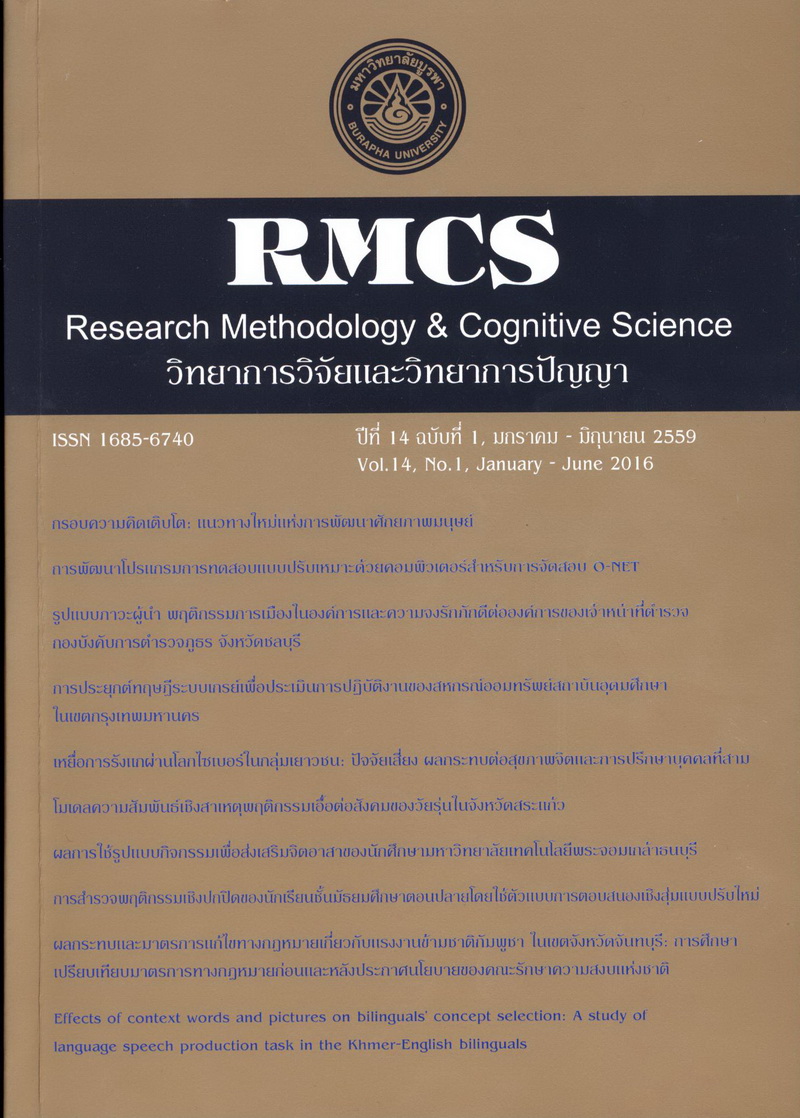เหยื่อการรังแกผ่านโลกไซเบอร์ในกลุ่มเยาวชน: ปัจจัยเสี่ยง ผลกระทบต่อสุขภาพจิตและการปรึกษาบุคคลที่สาม
Main Article Content
Abstract
การวิจัยนี้มีวัตุประสงค์ คือ 1) ศึกษาการตกเป็นเหยื่อการรังแกผ่านโลกไซเบอร์และพฤติกรรมรังแก
ผู้อื่นผ่านโลกไซเบอร์ของเยาวชนในสถานศึกษา 2) ศึกษาโมเดลความสัมพันธ์เชิงสาเหตุของการตกเป็นเหยื่อการ
รังแกผ่านโลกไซเบอร์ และ 3) เปรียบเทียบความแตกต่างระหว่างโมเดลความสัมพันธ์เชิงสาเหตุฯ ของเพศชายกับ
เพศหญิง โดยใช้ทฤษฎีการกระท าที่เป็นกิจวัตร (Routine activity theory) เป็นกรอบแนวคิดหลักในการศึกษา
ตัวแปรในโมเดลประกอบด้วย 7 ตัวแปร ได้แก่ พฤติกรรมเสี่ยงทางออนไลน์ ภาวะขาดการปกป้อง แรงจูงใจผู้กระท า
พฤติกรรมรังแกผู้อื่นผ่านโลกไซเบอร์ การตกเป็นเหยื่อการรังแกผ่านโลกไซเบอร์ การปรึกษาบุคคลที่สาม และ
สุขภาพจิตเชิงลบ กลุ่มตัวอย่างเป็นนิสิตมหาวิทยาลัยบูรพา อายุไม่เกิน 25 ปี จ านวน 428 คน เลือกโดยวิธีการสุ่ม
แบบง่าย เก็บข้อมูลด้วยแบบสอบถามออนไลน์ วิเคราะห์ค่าสถิติพื้นฐานด้วยโปรแกรม SPSS และโมเดลสมการ
โครงสร้าง (SEM) ด้วยโปรแกรม AMOS
ผลการวิจัยปรากฏว่านิสิตตกเป็นเหยื่อฯ และมีพฤติกรรมรังแกผู้อื่นฯ ในระดับต่ าถึงปานกลาง พบ
รูปแบบของการตกเป็นเหยื่อฯ และพฤติกรรมรังแกผู้อื่นฯ หลากหลาย โดยข้อมูลเพศชายและหญิงแตกต่างกัน
เล็กน้อย ผลการวิเคราะห์โมเดลความสัมพันธ์เชิงสาเหตุ พบว่าโมเดลที่สร้างขึ้นมีความสอดคล้องกลมกลืนกับ
ข้อมูลเชิงประจักษ์ในระดับพอใช้ ปัจจัยการมีพฤติกรรมรังแกผู้อื่นฯ ส่งผลต่อการตกเป็นเหยื่อฯ มากที่สุด เป็นผล
ทางตรงเชิงบวก รองลงมาคือพฤติกรรมเสี่ยงทางออนไลน์ เป็นผลทางอ้อมผ่านทางพฤติกรรมรังแกผู้อื่นฯ ส่วน
ปัจจัยที่ไม่ส่งผลคือภาวะขาดการปกป้อง และปัจจัยแรงจูงใจผู้กระท า ในด้านผลของตกเป็นเหยื่อฯ พบว่าส่งผล
ทางบวกต่อสุขภาพจิตเชิงลบ และต่อการปรึกษาบุคคลที่สาม การปรึกษาบุคคลที่สามส่งผลทางตรงเชิงบวกต่อ
สุขภาพจิตเชิงลบ ผลการเปรียบเทียบโมเดลเพศชายและหญิงพบว่าแตกต่างกันเล็กน้อย
Cyber-bullying victimization among youths: Risk factor, mental health impacts and reporting to the third person
The purposes of this study were to explore victimization and cyber-bullying behaviors
among youths in a college, to study a model explaining victimization and to compare male and
female model. The Routine activity theory was used to support the conceptual framework. The
model consisted of seven variables; Risky Online Behavior, Lack of Guardian Situation,
Motivation of Offender, Cyber-Bullying Behavior, Vitim of Cyber-Bullying, Reporting as a
Victim to the Third Person, and Negative Mental Health. The sample derived by means of
simple random sampling method, consisted of 428 Burapha University students, aged less than
25 years old. The research instrument was an online questionnaire. Descriptive statistics were
generated using SPSS; Structural Equation Modeling (SEM) was analyzed by AMOS.
The results demonstrated that the students were at low to moderate level of being
victimized and committing cyber-bullying. Moreover, there were various patterns of both being
bullied and bullying others; male and female were not much different. The SEM analysis
showed that the adjusted model was consistent with empirical data at an acceptable level. The
most influential variable on victimization was Cyber-Bullying Behavior with positive direct
effect, followed by Risky Online Behavior with indirect effect through Cyber-Bullying. On the
other hand, Lack of Guardian and Motivation of Offender had no influence on Victimization.
The consequences of Victimization, Victim of Cyber-Bullying had a positive direct effect on
Negative Mental Health and Reporting to the Third Person. In comparison, male and female
model were not much different.
Article Details
References
เดลินิวส์ออนไลน์. สืบค้นเมื่อ 1 ตุลาคม 2558 จาก http://www.dailynews.co.th/education/345786
ชวิตรา ตันติมาลา. (2555). “ซิ ม ซิ ม อิ” เพื่อน แก้ เหงา หรือ เพื่อน หยาบคาย. วารสารสถาบันวัฒนธรรมและ
ศิลปะ (Institute of Culture and Arts Journal), 13(2), 56-64.
เปรมฤดี บุญตามช่วย. (2550). การตกเป็นเหยื่อจากการคุกคามทางอินเตอร์เน็ต: ศึกษากรณีผู้ใช้โปรแกรมสนทนา
ทางอินเตอร์เน็ต. วิทยานิพนธ์หลักสูตรศิลปศาสตรมหาบัณฑิต สาขาวิชาอาชญาวิทยาและงานยุติธรรม.
กรุงเทพฯ: มหาวิทยาลัยมหิดล.
วิมลทิพย์ มุสิกพันธ์, ศิวพร ปกป้อง, นันทนัช สงศิริ และปองกมล สุรัตน์ (2552) พฤติกรรมการข่มเหงรังแกผ่านโลก
ไซเบอร์ของเยาวชนไทยในเขตกรุงเทพมหานคร. สมาพันธ์การวิจัยความเห็นสาธารณะแห่งประเทศไทย.
สถาบันวิจัยแห่งชาติเพื่อการพัฒนาเด็กและครอบครัว, สืบค้นเมื่อ 1 ตุลาคม 2558 จาก
http://www.momypedia.com/webboard/-625177/“อาชญากรตัวจ้อย”-ตัวป่วนโลกไซเบอร์
Amaraphibal, A., Rujipak, T., & Payakkakom, A. (2013). A model explaining violent behavior
among youth: A case study of middle school students in Bangkok, Thailand.
International Journal of Asian Social Science, 3(3), 703-726.
(http://www.aessweb.com/pdf-files/703-726.pdf)
Cohen, L. E., & Felson, M. (1979). Social change and crime rate trends: A routine activity
approach. American Sociological Review, 588-608.
Englander, E. K. (2011). MARC freshman study 2011: Bullying, cyberbullying, risk factors and
reporting. MARC Research Reports.Paper1.
(http://vc.bridgew.edu/cgi/viewcontent.cgi?article=1000&context=marc_reports)
Hentig, V. H. (1948). The criminal & his victim: Studies in the sociology of crime. Oxford England.
Yale University Press.
Hinduja, S., & Patchin, J. W. (2007). Offline consequences of online victimization: School violence
and delinquency. Journal of school violence, 6(3), 89-112.
National Crime Prevention Council ของสหรัฐอเมริกา. สืบค้นเมื่อ 15 เมษายน 2558. จาก
http://obullying.com/cyberbullying-bullying-statistics-2014-finally
O’Brien, N., & Moules, T. (2010). The impact of cyber-bullying on young people’s mental health.
Chelmsford: Anglia Ruskin University. (http://www.ncb.org.uk/media/111007/cyber-bullying_report.pdf)
Samoh, N., Boonmongkon, P., Ojanen, T. T., Samakkeekarom, R., & Guadamuz, T. E. (2014). Youth
perceptions on cyberbullying. Journal of Behavioral Science for Development, 6(1),
-363. (in Thai)
Schafer, S. (1977). Victimology: The victim and his criminal. Reston, Va.: Reston Publishing
Company.
Smith, P. K., Mahdavi, J., Carvalho, M., Fisher, S., Russell, S., & Tippett, N. (2008). Cyberbullying:
Its nature and impact in secondary school pupils. Journal of child psychology and
psychiatry, 49(4), 376-385.
Smith, P. K., Mahdavi, J., Carvalho, M., & Tippett, N. (2006). An investigation into cyberbullying, its
forms, awareness and impact, and the relationship between age and gender in
cyberbullying. Research Brief No. RBX03-06. London: DfES.
Veenstra, S. (2011). Cyberbullying: an explanatory analysis. (http://www.cyren-jeugd.nl/files/Veenstra,%20S.%20(2011)%20Cyberbullying%20-%20an%20explanatory%20analysis.pdf)
Wang, J., Nansel, T. R., & Iannotti, R. J. (2011). Cyber and traditional bullying: Differential
association with depression. Journal of Adolescent Health, 48(4), 415-417.
Will, J., & Clayburn, C. (2010). Psychological Impact of Cyber Bullying. University Business
Magazine. (http//www.unversitybusyness/article/psychological-impact-cyber-bullying)
Živko, M. (2011). Psychological aspects of cyberspace. THE FUTURE OF INFORMATION
SCIENCES,99. (http://hnk.ffzg.hr/bibl/InFuture2011/PDF/01%20e-Society/1-11%20Zivko,%20Psychological%20Aspects%20of%20Cyberspace.pdf)

